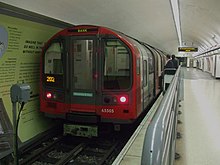Waterloo & City line
| Waterloo & City | |||||||||||||||||||||
|---|---|---|---|---|---|---|---|---|---|---|---|---|---|---|---|---|---|---|---|---|---|
 |
|||||||||||||||||||||
| Overview | |||||||||||||||||||||
| Type | Deep Tube | ||||||||||||||||||||
| System | London Underground | ||||||||||||||||||||
| Stations | 2 | ||||||||||||||||||||
| Ridership | 15.892 million (2011/12) passenger journeys | ||||||||||||||||||||
| Colour on map | Corporate Turquoise | ||||||||||||||||||||
| Website | tfl.gov.uk | ||||||||||||||||||||
| Operation | |||||||||||||||||||||
| Opened | 1898 | ||||||||||||||||||||
| Depot(s) | Waterloo | ||||||||||||||||||||
| Rolling stock |
4 cars per trainset |
||||||||||||||||||||
| Technical | |||||||||||||||||||||
| Line length | 2.37 km (1.47 mi) | ||||||||||||||||||||
| Track gauge | 1,435 mm (4 ft 8 1⁄2 in) | ||||||||||||||||||||
|
|||||||||||||||||||||
The Waterloo & City line is a short, fully underground railway line in central London, England. Part of the London Underground rapid transit network, it operates as a shuttle service between Waterloo and Bank stations with no intermediate stops. Its primary traffic consists of commuters from SW London, Surrey and Hampshire arriving at Waterloo mainline station to the City of London, and for this reason the line does not normally operate on Sundays or public holidays.
The line was built by the Waterloo & City Railway Company and opened for service on 11 July 1898 (at the time, Bank station was named "City"). When it opened it was the second electric tube railway in London, after the City and South London Railway (now part of the Northern line). For much of its existence, it was owned and operated by two mainline rail companies, before it was nationalised into British Rail. Operations were transferred to London Underground in 1994 following a major refurbishment and replacement of rolling stock.
The Waterloo & City line is by far the shortest line on the entire London Underground network, with a line length of 2.37 km (1.47 miles), and an end-to-end journey lasting just four minutes. In absolute terms, it is the least used line on the network, carrying just over 15 million passengers annually. However, in terms of the average number of journeys per mile, it is the second most intensively-used line, behind only the Victoria line.
The London and South Western Railway (LSWR) reached Waterloo Bridge in 1848, serving routes from Southampton and Richmond. (The name of the terminal station was later changed to Waterloo, and this name is used in the remainder of this article.)
The location was some distance short of the principal commercial area of the City of London, and as regular business travel developed the inconvenience of the location became an issue. The LSWR had hoped to build a line eastwards to near London Bridge but the slump following the railway mania, and the high cost of building through the area, led to abandonment of the idea. When the South Eastern Railway built its extension from London Bridge to Charing Cross, a connecting railway line from it to Waterloo was built; but friction and competitive hostility between the companies frustrated beneficial use of the connection and it fell into disuse at the end of 1867.
...
Wikipedia
